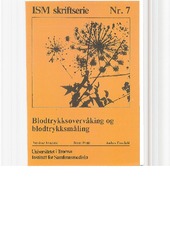Prevalence and reasons for intentional use of complementary and alternative medicine as an adjunct to future visits to a medical doctor for chronic disease
Permanent link
https://hdl.handle.net/10037/12635Date
2018-03-27Type
Journal articleTidsskriftartikkel
Peer reviewed
Author
Kristoffersen, Agnete Egilsdatter; Stub, Trine; Musial, Frauke; Fønnebø, Vinjar; Lillenes, Ola; Norheim, Arne JohanAbstract
Intentional use of complementary and alternative medicine (CAM) has previously only been researched in small, possibly biased, samples. There seems to be a lack of scientific information regarding healthy individual's attitudes and presumed use of CAM. The aim of this study is to describe prevalence and characteristics of participants who intend to see a CAM provider compared to participants who intend to see a medical doctor (MD) only when suffering from a chronic, non- life-threatening disease and in the need of treatment. Further to describe differences between the groups regarding expected reasons for CAM use and expected skills of CAM providers.
METHOD: The survey was conducted in January 2016 as part of the "TNS Gallup Health policy Barometer". In total, 1728 individuals aged 16-92 years participated in the study, constituting an overall response rate of 47%. The survey included questions regarding opinions and attitudes towards health, health services and health politics in Norway.
RESULTS: The majority of the participants (90.2%) would see a MD only if they were suffering from a chronic, non- life-threatening disease and were in the need of treatment. Men over the age of 60 with a university education tended to see a MD only. Only 9.8% of all respondents would in addition visit a CAM provider. Being an intentional user of a MD + CAM provider was associated with being a woman under the age of 60. The respondents believed that CAM providers have professional competence based on formal training in CAM. They also believed that individuals seeing a CAM provider have poor health and are driven by the hope of being cured. Further, that they have heard that others have good experience with such treatment.
CONCLUSION: Intentional use of CAM is associated with positive attitudes, trustworthiness, and presumed positive experiences in the CAM-patient-setting. Intentional CAM users also have the impression that CAM providers have professional competence based on formal training in alternative therapies.
METHOD: The survey was conducted in January 2016 as part of the "TNS Gallup Health policy Barometer". In total, 1728 individuals aged 16-92 years participated in the study, constituting an overall response rate of 47%. The survey included questions regarding opinions and attitudes towards health, health services and health politics in Norway.
RESULTS: The majority of the participants (90.2%) would see a MD only if they were suffering from a chronic, non- life-threatening disease and were in the need of treatment. Men over the age of 60 with a university education tended to see a MD only. Only 9.8% of all respondents would in addition visit a CAM provider. Being an intentional user of a MD + CAM provider was associated with being a woman under the age of 60. The respondents believed that CAM providers have professional competence based on formal training in CAM. They also believed that individuals seeing a CAM provider have poor health and are driven by the hope of being cured. Further, that they have heard that others have good experience with such treatment.
CONCLUSION: Intentional use of CAM is associated with positive attitudes, trustworthiness, and presumed positive experiences in the CAM-patient-setting. Intentional CAM users also have the impression that CAM providers have professional competence based on formal training in alternative therapies.
Description
Source at https://doi.org/10.1186/s12906-018-2179-8.
Publisher
BioMed CentralCitation
Kristoffersen, A.E., Stub, T., Musial, F., Fønnebø, V., Lillenes, O. & Norheim, A.J. (2018). Prevalence and reasons for intentional use of complementary and alternative medicine as an adjunct to future visits to a medical doctor for chronic disease. BMC Complementary and Alternative Medicine,18(1):109. https://doi.org/10.1186/s12906-018-2179-8Metadata
Show full item recordCollections
Related items
Showing items related by title, author, creator and subject.
-
Physical activity and perceived health among adolescents in Troms. Data based on Fit Futures - a health survey among adolescents
Tennebø, Kjetil (Master thesis; Mastergradsoppgave, 2013-07-02)Background: Perceived health is a predictor of morbidity and mortality in adults and has been an important measure of the general health status in population health studies for decades. Thus, perceived health during adolescence should be of high interest from a Public Health perspective. The aim of this thesis was to investigate the association between leisure time physical activity and perceived ... -
Attitudes and knowledge about direct and indirect risks among conventional and complementary health care providers in cancer care
Stub, Trine; Quandt, Sara A.; Arcury, Thomas A.; Sandberg, Joanne C.; Kristoffersen, Agnete Egilsdatter (Journal article; Tidsskriftartikkel; Peer reviewed, 2018-01-31)Background: Many complementary therapies offer benefits for patients with cancer. Others may be risky for patients due to negative interactions with conventional treatment and adverse effects. Therefore, cancer patients need guidance from health care providers to assess complementary modalities appropriately to receive benefits and avoid harm. <br> Method: In a self-administered questionnaire-based ... -
Blodtrykksovervåking og blodtrykksmåling
Kvamme, Jan-Ivar; Nesje, Bernt; Forsdahl, Anders (Others; Andre, 1983)Som ledd i en bedre blodtrykksbehandling, har vi utarbeidet vedlagte skjema for blodtrykksovervåkning. Hensikten med skjemaet er at en skal få en bedre oversikt over anamnese, utredninger og kontroller. Et vesentlig punkt i blodtrykksovervåkningen er også en standardisering av målemetodene. Vi har derfor gitt anbefalinger om standardisering og omtalt en del feilkilder i forbindelse med målingene.


 English
English norsk
norsk


